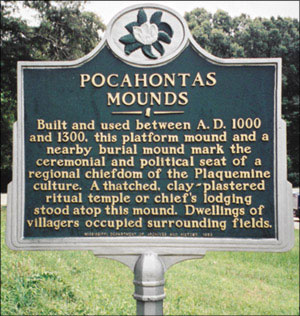Introduction
From June 7 to July 1, 2004, Cobb Institute researchers conducted investigations at the Pocahontas Mound A site (22Hi500) in northeastern Hinds County, MS. Cobb Junior Research Associate Jeffrey Alvey served as Field Director for the project. He also served as Co-PI along with Cobb Senior Researchers Janet Rafferty, Evan Peacock and S. Homes Hogue. The field crew included Paula Andras (MSU MA 2003), Brad Atkins (MSU BA 2002), Russ Reed (MSU BA 2003), Robert Myrick (MSU AN student), and Justin Byrnes (MSU AN student). The project was funded by the Mississippi Department of Transportation (MDOT). The investigations were necessitated by MDOT plans to transform the Pocahontas Mound A site into a roadside park. The Pocahontas site is a Mississippi Landmark, and is listed on the National Register of Historic Places. The park will include an educational center designed to provide information to the public concerning the site’s cultural and historical importance.

Field Work
Field work was designed to provide an understanding of the site’s boundaries and the location of intact cultural deposits of prehistoric significance. The objective was to provide information for use by MDOT planners so that construction activities would not adversely impact the site’s intact cultural deposits. The field design involved a two-stage strategy including magnetic gradiometer survey and systematic shovel-testing across the project area on a 20 meter grid. The gradiometer survey employed use of a remote sensing instrument (Geoscan FM-256 fluxgate gradiometer) that measures the magnetic properties of subsurface features such as prehistoric houses, palisade walls, and pits, and maps their locations.
These investigations proved quite fruitful, providing a more holistic picture of the site’s structure and significance. The recovered evidence suggests that the Pocahontas Mound A site was not simply a ceremonial center, visited only periodically for ceremonial purposes. The investigations revealed evidence of midden deposits, midden filled pits, postholes, and vast amounts of animal bone and fired clay: all indicators of more intense, sustained occupation. The radiocarbon dates and artifact evidence from the site suggest that Pocahontas was occupied first in the Middle-Late Archaic period (4000-1000 B.C.). This evidence also suggests that substantial occupation at the site appears to have begun during the Coles Creek period and continued well into the Plaquemine period, spanning a period from around A.D. 800 to 1300.
Visitor's Center
In Spring of 2008 the Pocahontas Visitor's center was opened. The center provides a rest stop for traveler's along with an educational center and interpretive trail designed to provide information to the public concerning the site’s cultural and historical importance. There is no charge for visiting the site.
Pocahontas Bibliography
Brown, Calvin S.
1926 - Archaeology of Mississippi. Mississippi Geological Survey. University of Mississippi.
Ford, James A.
1936 - Analysis of Indian Village Site Collections from Louisiana and Mississippi. Louisiana Geological Survey, Anthropological Study No. 9. New Orleans, Louisiana.
Hogue, S. Homes
2006 - Evaluating the Reliability of Fluoride Dating at Two Prehistoric Mound Sites in Mississippi. Journal of Field Archaeology 31(3): 307-315.
Rafferty, Janet, Jeffrey Alvey, S. Homes Hogue, Evan Peacock and Robert McCain
2005 - Final Report on Archaeological Testing at the Pocahontas Mound A Site (22Hi500), Hinds County, Mississippi. Cobb Institute of Archaeology, Mississippi State University. Report submitted to the Mississippi Department of Transportation. On file, MDOT, Jackson, Mississippi.
Rafferty, Janet, Jeffrey Alvey, and S. Homes Hogue
2005 - Test Excavations and Analysis of MDOT Collections, Pocahontas Mound A Site, 22HI500. Paper presented at the 2005 Midsouth Archaeological Conference, Tunica, Mississippi.
Rucker, Marc D.
1976 - Archaeological Investigations at Pocahontas Mound A, Hinds County, Mississppi. Mississippi State Highway Department. Archaeological Excavation Report No. 3.
Steponaitis, Vincas P.
1991 - Contrasting Patterns of Mississippian Development. In Chiefdoms: Power, Economy, and Ideology, edited by T.K. Earle, pp. 193-228. Cambridge University Press, Cambridge.